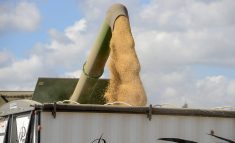Traders like to say that the best cure for low prices is low prices, but the medicine certainly doesn’t taste very good going down.
The basic economic theory at play is that prices will eventually become so cheap that end users will increase their purchases and give values a boost. Longer term, low prices also discourage farmers from planting a crop, so seeded area declines and supplies tighten.
All of that takes time to work, and barring an outside catalyst, any prolonged strength in the canola market could take awhile.
Read Also

Manitoba boosts stake in cereals centre to $23.5 million
Premier Wab Kinew said the additional project funds will help ‘Trump-proof’ the provincial economy.
Canola futures fell to contract lows in the middle of August, with no real sign that the downtrend is slowing. Seasonal harvest pressure is just around the corner, while near ideal growing conditions for soybeans in the United States weigh heavily on that market.
Funds: The funds have been sitting on a large net short position of over 100,000 contracts for most of the summer, indicating they’re betting on prices to move lower. Eventually they will want to book profits on those bearish bets and buy back those previously sold positions at a profit. However, a catalyst is lacking.
Charts: November canola moved below $570 per tonne during the week, opening the door for a test of the next support at $550 per tonne. After that, there’s no real support on the weekly chart until the psychological $500 per tonne area.
Harvest: Newly harvested supplies will soon become available, which typically weighs on prices. However, weather scares also have a habit of materializing during harvest.
Rail stoppage: Grain movement on Canada’s two major railways could be halted as of Aug. 22, as contract negotiations between the union representing 9,300 workers and the railways have yet to yield an agreement. A lockout or strike would be an extremely bitter pill to swallow for the agricultural markets at just the wrong time of year.















